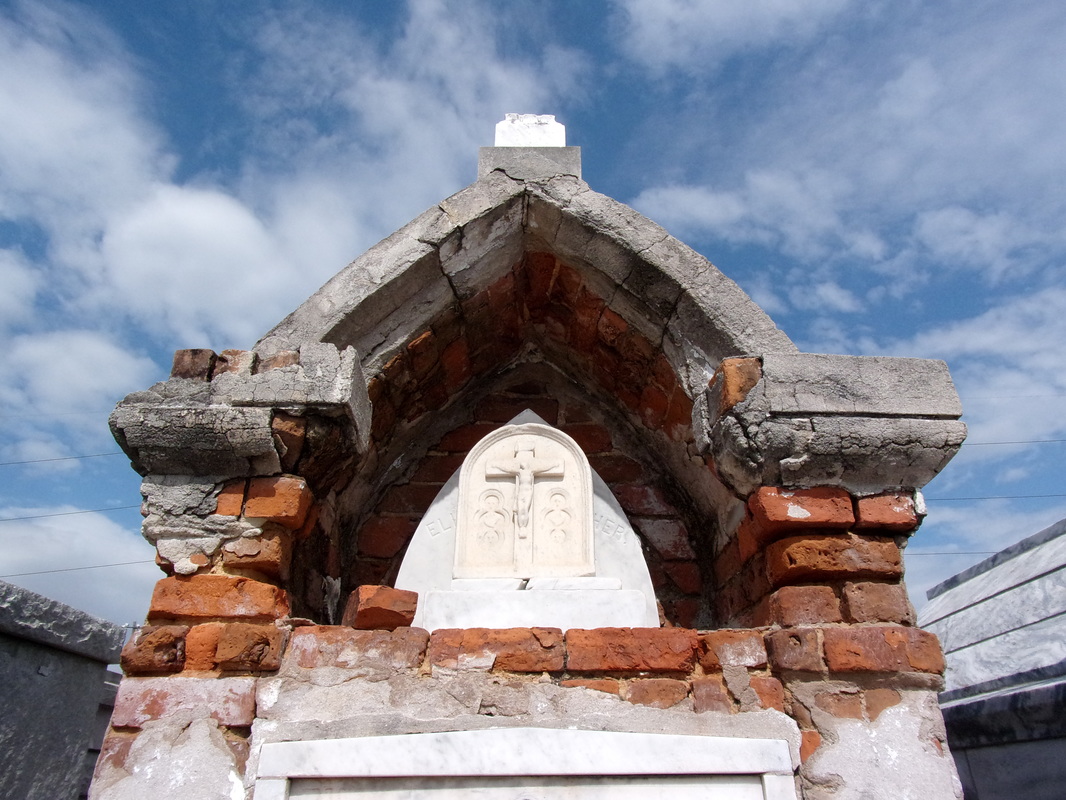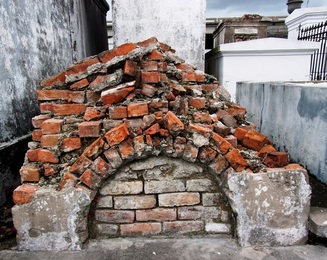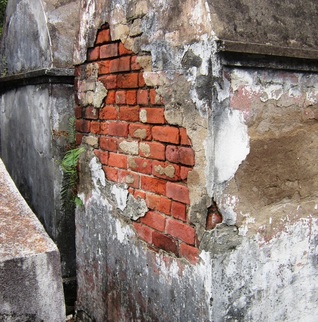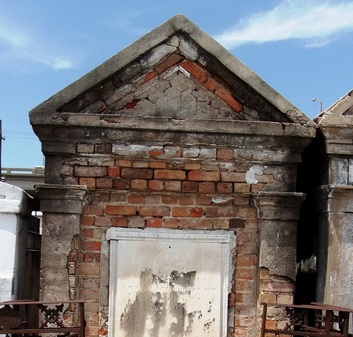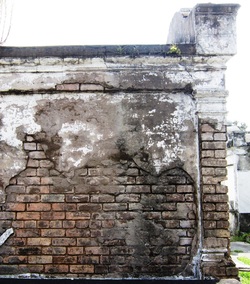|
Part One of Three “Reds” and “Tans” –hand-molded, wire-cut and pressed: Much can be learned from the bricks that comprise any one tomb. Brick identification can teach us about the construction date of the tomb, later alterations, quality of original construction, and cultural connections of the interred. It can help us understand the process of development in a cemetery, demolition and rebuilding, and where repairs were made. The history of New Orleans brick is as complex as its rich industrial and commercial history. However, the general narrative history of New Orleans brick is simple: “soft reds” were made from the clay of the Mississippi River, otherwise known as “batture,” and “hard tans” were made from the clays found around Lake Pontchartrain.[1] While this narrative is generally true, it belies the greater complexity of masonry in the Crescent City, in which new technologies and new commercial infrastructure compounded available brick types and styles. New Orleans River Brick New Orleans “soft reds” were likely the first masonry units manufactured in the city in the eighteenth century. Using the most basic and common of methods, brickmakers would mine batture from the river’s bank, allow it to dry, temper it, mold it, and fire it. Brick firing prior to the industrial revolution was almost exclusively accomplished without special equipment. Clay was molded in wooden molds, allowed to dry or cure, and then fired. These bricks can be bright or dull red, with soft edges. New Orleans “soft red” or “river brick” continued to be made through the nineteenth century. When we see red river brick in New Orleans cemeteries, their presence alone does not suggest early nineteenth century construction. However, soft reds are much more common in the oldest cemeteries in the city: St. Louis Cemeteries No. 1 and 2, and to a lesser extent Lafayette Cemetery No. 1. We see them in single-vault step tombs, wall vaults, and other elements of cemetery landscapes that represent the earliest phases of construction. It should be mentioned here that, generally speaking, we should seldom see bricks at all. New Orleans reds are so soft that exposure to the humid elements and temperature cycles of our local climate can cause them to deteriorate. Historic craftsmen were aware of this and typically coated tombs with lime-based stucco, which protected the brick beneath. Stucco coating was also applied to hide the appearance of bricks which were irregular in size and edges and were not considered aesthetically pleasing.[2] “Lake” or St. Tammany Brick
New Orleans “tans,” historically referred to as “lake brick,” were similarly manufactured during the first half of the nineteenth century. Instead of river batture, they were created from clay sourced north and east of New Orleans. Typically, this meant deposits near Lake Pontchartrain, but a number of other sources in St. Tammany parish were also used.[1] The mineral content of St. Tammany clays produced a tan-colored brick, typically with dark inclusions of iron, bauxite, and other impurities. Such bricks were significantly more durable than river bricks.[2] While lake bricks became the standard for a great deal of city construction by the 1850s, there were no requirements for the construction of tombs. Alternately, city ordinance did require that all tombs be “plastered” with protective stucco, which meant that cheaper bricks could be utilized. For this reason it is not surprising that river bricks remained the norm in tomb construction until around the time of the Civil War. Hand-molded lake and river bricks were easily manufactured and acquired locally. Yet the hub of trade and growth that was nineteenth century New Orleans invited a great deal more in the way of building materials and masonry units. Furthermore, cemetery construction typically represents the aesthetic and construction tradition of the memorialized individual or individuals. The best example of this trend can be seen in the Protestant and other Northern-extracted cemeteries of the city.[3] [1] Ellis, Frederick S., St. Tammany Parish: L’Autre Cote du Lac (Gretna: Pelican Publishing, 1981, 108. [2] “An Ordinance to Establish a Ferry near the St. Mary’s Market, and Connected with the City of Lafayette,” True American, November 20, 1838, 1. [3] “Building Material, Bricks, Firewood,” New Orleans Daily Crescent, August 02, 1859, 4. Advertising brick from France, England, and America.
1 Comment
Randy Bibb
5/14/2020 06:43:03 am
The River Brick is also known, colloquially, as "sugar brick" because it can be ground down to a sugary powder consistency. This is not necessarily a common colloquialism and the use of it largely died out (pardon the expression) a long time ago. Many of the older generation remember it, however, and I would like to see it resurrected. (Again....pardon.)
Reply
Your comment will be posted after it is approved.
Leave a Reply. |
About the Author:Emily Ford owns and operates Oak and Laurel Cemetery Preservation, LLC. Archives
November 2019
Categories
All
|
- About
-
Restoration
- Services
-
Portfolio
>
- Turning Angel Statue, Natchez, MS
- Ledger Monument, Baton Rouge, LA
- Pyramid Statuary, New Orleans, LA
- Bronze and Granite Monument, Carville, LA
- Box Tomb, New Orleans, LA
- Vernacular Concrete Monument, Pensacola, FL
- 1830s Family Tomb, Covington, LA
- 1850s Family Tomb, New Orleans, LA
- 1880s Family Tomb, New Orleans, LA
- Headstone and Monument Restorations, Pensacola, FL
- Society Tomb, New Orleans, LA
- Education
- Blog
- Contact
|
Oak and Laurel Cemetery Preservation, LLC is a preservation contractor in New Orleans, Louisiana, specializing in historic cemeteries, stone conservation, educational workshops and lectures. Oak and Laurel serves the region of the Southeastern US.
|
QUICK LINKS |
CONNECT |
Proudly powered by Weebly

